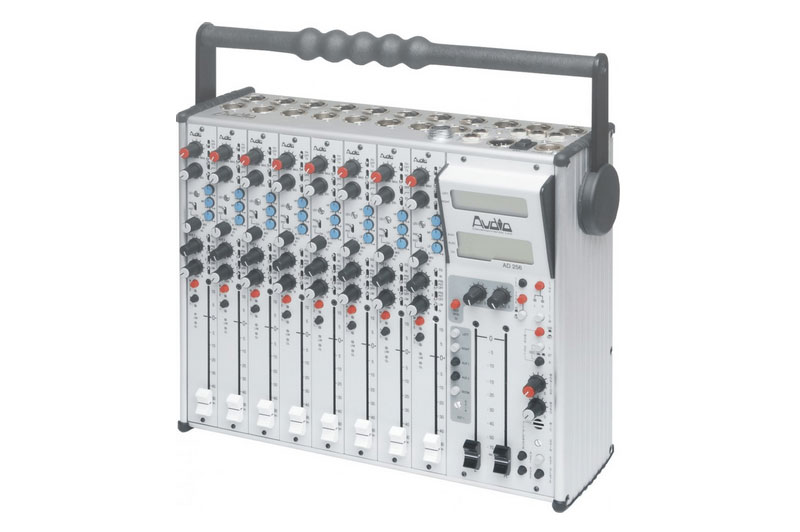Audio Developments AD256 Drama & Film Location Mixer
AD256 is another addition to the Audio Developments Ltd range of portable mixers, having comprehensive facilities set out in an ergonomically friendly design and all contained within a robust and rugged aluminum case with a relatively small footprint.
Description
This item is a special order. Contact your Trew Audio rep for more information on delivery time.
AD256 is another addition to the Audio Developments Ltd range of portable mixers, having comprehensive facilities set out in an ergonomically friendly design and all contained within a robust and rugged aluminum case with a relatively small footprint.
The features and specification are based on the well established AD255 Mixer. Input channel limiter, continuously variable HPF and mute switch are the main additions. As with the other models within the range, professional components are used throughout – including Penny and Giles 100mm, long-stroke, conductive plastics faders.
Location sound professionals now require multi-track record facilities; the channel direct outputs provide the necessary features. By use of an additional switch these outputs can source other signals if the direct signal is not required, (Main Output and Auxiliaries). This without compromising the simplicity of operation and reliability as with its counterpart the AD255.
Key Features:
- Low noise microphone amplifier with powering for 48V Phantom and 12V Tonader (TA) powering.
- 6 to 12 input frame, mic or line selection.
- A simple, but effective, three band equaliser, proved and approved under field conditions, in use throughout the AD140 Series of mixers.
- Inputs are balanced and protected against radio-frequency interference. A continuously variable high-pass-filter protects against low-frequency saturation.
- The main stereo output is transformer balanced and has separate left and right fader control.
- Two auxiliary outputs are transformer balanced and have separate master rotary controls. Auxiliary 1 & 2 are routed from each input using a 3 position switch (off, pre & post fader). Auxiliary 2 has a rotary level control on each input.
- A mono output of the left and right signals is also transformer balanced.
- Direct outputs from each input channel are unbalanced using a very low output impedance drive amplifier enabling high drive capability and minimising line interference.
- Limiters are incorporated on both the inputs and outputs. The main output limiter can be linked for stereo operation. LEDs indicate limiting action.
- Two LCD meters display – either PPM or VU – main output, auxiliary output and PFL levels of each input. Useful for monitoring level at a direct output. Battery level and monitor status (Direct or Return) are also indicated. Back-light illumination is also included.
- Internal oscillator at either 1kHz or 10kHz frequency. The oscillator signal replaces the signal on the output when selected.
- An internal microphone enables the mixer operator to communicate with the main output (SLATE), with each auxiliary and an external outstation (EXT). The outstation (Private Line) receives a monitor signal, selected using a series of push-button switches.
- The headphone monitor may be switched between main output, auxiliary outputs and returns. PFL overrides the selected monitor signal. Monitor selection allows left, right, left/right, auxiliary 1, auxiliary 2, auxiliary 1 + 2 and returns to be routed to the headphone output. An M-S matrix amplifier can be inserted to main or auxiliary outputs in the M-S domain.
- An electronically balanced stereo tape return appears on a pair of jack sockets on the connector panel.
- All inputs and outputs are presented on one surface of the case. The inputs, main output and direct outputs are on XLRs. Auxiliary
- outputs, returns and headphone output are on ¼ inch jack sockets.
- The mixer can be powered from an internally fitted battery box (8 x C cells) or an external DC source (12V to 15V DC)
Related Products
Product Categories
- Bags & Harnesses
- Bargain Bin
- Books
- Boom Poles
- Cables & Adapters
- Camera Interfaces
- Case
- Cases
- Cases, Bags & Harnesses
- Clearance
- Communications
- Connectors
- Deal Center
- DSLR Audio Solutions
- Expendables
- Headphones
- Holiday Clearance
- In-Ear-Monitors
- Interfaces
- Microphones & Accessories
- Mixers
- Motorola
- NAGRA
- New Product
- Podcast
- Power Solutions
- PPE
- Press Boxes
- Pro Audio Converters
- Pro Video
- Recorders
- Slates & Timecode
- Sound Carts
- Straps & Cases
- Trew Merchandise
- Uncategorized
- Used
- Walkie-Talkies
- Wireless


 US
US  Canada
Canada 


